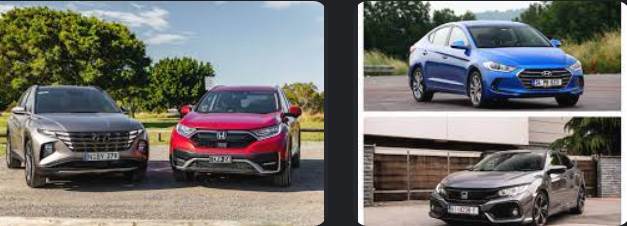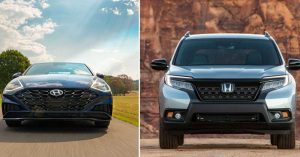In the world of automobiles, Honda and Hyundai are names that resonate deeply with quality, reliability, and innovation. Honda, a Japanese automotive giant established in 1948, has made its mark with an impressive range of vehicles known for their durability and performance. On the other hand, Hyundai hailing from South Korea, has seen remarkable growth since its inception in 1967. They have consistently provided vehicles that combine affordability, technological prowess, and modern design.
The journey of Honda in the automotive industry started with the production of motorcycles and quickly expanded to manufacturing automobiles, where they proved their engineering excellence with models like the Civic, Accord, and CR-V. On the other hand, Hyundai has snowballed to become the world’s third-largest vehicle manufacturer, with successful models like the Sonata, Elantra, and Santa Fe. Despite their differing origins, both brands have displayed a consistent commitment to innovation, customer satisfaction, and product quality.
Contents
This comparison aims to provide a comprehensive understanding of the strengths and characteristics of Honda and Hyundai vehicles. We aim to highlight critical aspects such as performance, driving experience, interior space, utility, and safety features. This analysis will serve as a detailed guide for potential buyers to make informed decisions and choose the vehicle that nicely suits their preferences and needs.
Performance and Driving Experience

Overview of Powertrains and Their Impact on Performance
A vehicle’s powertrain, which includes the engine, transmission, and drivetrain, plays a crucial role in determining its overall performance. It impacts the vehicle’s acceleration, top speed, fuel efficiency, and driving feel. Whether you prefer the adrenaline rush of sporty performance or the quiet efficiency of a smooth ride, the powertrain choice will significantly impact your driving experience.
| Honda | Hyundai |
|---|---|
| Honda’s Noteworthy Engines and Their Driving Feel Honda’s lineup of engines offers a diverse range of performance characteristics to meet different driving preferences—for example, the turbocharged engines in the Civic Type R and Accord. The Civic Type R, equipped with a 2.0L VTEC Turbo engine, offers exhilarating performance and high-speed stability, making it a favorite among car enthusiasts. With its 1.5L and 2.0L Turbo engines, the Accord provides a perfect balance of power and fuel efficiency for daily commuting and long drives. |
Hyundai’s Engine Technologies and Their Impact on Driving Experience Hyundai’s engine technologies are designed to provide an engaging driving experience while prioritizing efficiency and reliability. For example, the Theta II engine in the Sonata and Santa Fe offers robust performance and smooth power delivery. Hyundai also provides a range of turbocharged engines, hybrid powertrains, and electric motors, ensuring they have a vehicle to suit every driver’s needs. |
Comparison of Fuel Efficiency between Honda and Hyundai Models
Fuel efficiency is a crucial factor for many car buyers, and both Honda and Hyundai have models that excel in this area. Honda’s Eco Assist System and Continuously Variable Transmission (CVT) have significantly improved fuel efficiency in the Civic and CR-V models. On the other hand, Hyundai’s lineup includes several hybrid and electric vehicles, like the Ioniq and Kona Electric, which offer outstanding fuel efficiency and lower emissions.
Interior and Cargo Space

Importance of Interior and Cargo Space in Selecting a Vehicle
When considering a new vehicle, the interior and cargo space are pivotal in determining whether it can accommodate your lifestyle. Be it a family trip, hauling gear for your favorite hobby, or ensuring comfortable commutes, the space inside your vehicle truly matters. Thus, a well-designed interior with ample cargo space enhances the overall functionality and appeal of the car.
| Honda | Hyundai |
|---|---|
| Overview of Honda’s Interior and Cargo Space Honda is known for their intelligent utilization of interior space. Their vehicles typically provide ample headroom and legroom, even in the rear seats. In addition, Honda vehicles are celebrated for their practical and user-friendly interiors, with well-placed controls and excellent visibility. For cargo space, models like the CR-V and Pilot stand out with generous storage room. The Honda Odyssey minivan is recognized as one of the leaders in its class regarding cargo capacity. |
Review of Hyundai’s Interior and Cargo Space On the other hand, Hyundai is praised for its upscale and well-appointed interiors. Hyundai vehicles offer stylish, comfortable, and spacious interiors, often equipped with the latest technology. Hyundai also excels in cargo capacity, with models like the Santa Fe and Tucson offering generous space. The Hyundai Palisade, their flagship SUV, boasts one of the largest cargo spaces in its class. |
Side-by-Side Comparison of Popular Models
Let’s compare the interior and cargo space of popular models from Honda and Hyundai to give you a clearer perspective.
| Model | Honda Interior/Cargo Space | Hyundai Interior/Cargo Space |
|---|---|---|
| Compact SUV | The Honda CR-V offers 105.9 cubic feet of passenger volume and up to the smaller 75.8 cubic feet of cargo space. | Hyundai Tucson provides a total interior volume of 102.2 cubic feet with cargo space up to 61.9 cubic feet. |
| Midsize Sedan | The Honda Accord provides a roomy interior with 105.6 cubic feet of passenger volume and a generous 16.7 cubic feet trunk space. With its sleek design, | The Hyundai Sonata offers 104.4 cubic feet of interior volume and 16 cubic feet of trunk space. |
| Minivan | Honda Odyssey, a leader in its segment, offers up to 163.6 cubic feet of passenger volume and a staggering 158 cubic feet of cargo space behind the first row. | Hyundai does not currently produce a minivan for the U.S. market. |
Through this comparison, one can see how both brands prioritize comfortable interiors and functional cargo spaces. It also showcases the distinct approach each brand takes in designing and arranging their interior space.
Technology and Features

The Role of Technology in Modern Vehicles
The role of technology in modern vehicles cannot be understated. It defines and enhances the driving experience, providing safety, comfort, and entertainment. Today, drivers expect high-tech features, from simple smartphone connectivity to advanced driver-assist technologies.
| Honda | Hyundai |
|---|---|
| Highlighting Honda’s Noteworthy Tech Features Honda prides itself on offering advanced technology features even in its base models. Its comprehensive suite of driver-assistive technologies, Honda Sensing, is standard in most models. It includes Collision Mitigation Braking System, Road Departure Mitigation System, and Adaptive Cruise Control. Honda uses its proprietary Display Audio infotainment system for entertainment, which supports Apple CarPlay and Android Auto. |
Showcasing Hyundai’s Advanced Features On the other hand, Hyundai brings many tech features via their Hyundai SmartSense package. It encompasses features like Forward Collision-Avoidance Assist, Lane Keeping Assist, and Smart Cruise Control. Hyundai also offers Blue Link, a connected car system with remote start and diagnostic data. Hyundai’s infotainment systems provide Apple CarPlay, Android Auto, and even a wireless charging pad in specific models. |
Comparison of Honda and Hyundai’s Tech Offerings
 When comparing the technological offerings of Honda and Hyundai, we see that both are committed to providing customers with the latest features. Let’s have a side-by-side comparison of their offerings.
When comparing the technological offerings of Honda and Hyundai, we see that both are committed to providing customers with the latest features. Let’s have a side-by-side comparison of their offerings.
| Feature | Honda | Hyundai |
|---|---|---|
| Infotainment System | Honda’s Display Audio infotainment system, supporting Apple CarPlay and Android Auto. | Hyundai’s infotainment system, which also supports Apple CarPlay and Android Auto, along with available wireless charging. |
| Driver Assist Technology | Honda Sensing Suite, which includes features like Collision Mitigation Braking System and the famous Road Departure Mitigation System. | Hyundai SmartSense which includes features like Forward Collision-Avoidance Assist and Lane Keeping Assist. |
| Connected Car System | HondaLink, offering remote start, vehicle location, and diagnostic data. | Hyundai Blue Link offers similar features like remote start and diagnostic data. |
In conclusion, Honda and Hyundai have made strides to ensure their vehicles are equipped with the latest tech features. While the offerings are somewhat similar, the experience they provide to the user may differ based on individual preferences and expectations.
Utility and Convenience

Importance of Utility in Today’s Cars
In the rapidly evolving landscape of the automotive industry, utility stands out as a significant factor influencing consumer choice. The modern vehicle is more than just a means of transportation; it must adapt to various roles – a mobile office, a cargo carrier, or a comfortable lounge for long trips. Hence, carmakers must incorporate designs and features that offer real-world utility and convenience.
| Honda | Hyundai |
|---|---|
| Overview of Honda’s Utility Features Honda is no stranger to delivering utility and convenience to its customers. A significant example is Honda’s Magic Seat system, available in models like the Honda Fit, which allows the rear seats to fold in several ways to accommodate different types of cargo. Furthermore, Honda’s SUVs, like the Pilot and the CR-V, offer power tailgate features, significantly enhancing their utility. |
Overview of Hyundai’s Utility Features Similarly, Hyundai understands the need for utility and convenience. Their vehicles, such as the Santa Fe and Tucson, offer a hands-free power liftgate that opens automatically when it senses the key fob nearby. This feature proves invaluable when your hands are full. |
Comparison of Utility Features between Honda and Hyundai
Let’s look at how Honda and Hyundai stack up regarding utility features.
| Feature | Honda | Hyundai |
|---|---|---|
| Flexible Seating | Honda’s Magic Seat system allows for various seat configurations to maximize cargo space. | Hyundai also offers foldable rear seats, though without a specific system like Honda’s Magic Seat. |
| Power Tailgate | Honda offers a power tailgate feature on models like the Pilot and CR-V. | Hyundai’s SUVs like the Santa Fe and Tucson also offer a hands-free power liftgate feature. |
Both Honda and Hyundai have significant offerings in utility and convenience. The power tailgate feature is common, but Honda’s unique Magic Seat system offers a distinct edge. However, the choice will inevitably depend on the specific needs and preferences of the user.
Safety Measures

The Significance of Safety Features in Vehicles
As we progress into the era of autonomous and intelligent vehicles, safety features in cars have never been more critical. Modern automobiles have various safety measures to prevent accidents, protect passengers during mishaps, and assist post-accident rescue. From advanced airbags to autonomous emergency braking, these features have saved countless lives and reduced the severity of injuries on the road.
| Honda | Hyundai |
|---|---|
| Honda’s Approach to Safety and Notable Features For Honda, safety has always been paramount. The Honda Sensing® suite, their proprietary collection of security and driver-assistive technologies, is a testament to this commitment. Features like Collision Mitigation Braking System™ (CMBS™), Road Departure Mitigation System (RDM), and Adaptive Cruise Control (ACC) are designed to aid drivers in critical situations and reduce the potential for accidents. |
Hyundai’s Safety Measures and Innovations Hyundai has made impressive strides in the realm of safety as well. Their Hyundai SmartSense package bundles various safety technologies, including Forward Collision-Avoidance Assist (FCA), Lane Keeping Assist (LKA), and Smart Cruise Control (SCC), ensuring maximum protection for both passengers and pedestrians alike. |
Comparison of Safety Ratings between Honda and Hyundai Models
Given their commitment to safety, it’s no surprise that both Honda and Hyundai have impressive safety ratings. Below, we compare some safety ratings between popular models of these manufacturers.
| Model | Honda Safety Ratings | Hyundai Safety Ratings |
|---|---|---|
| Honda Accord | Received a 5-star overall safety rating from the NHTSA in 2023. | N/A |
| Hyundai Sonata | N/A | Also received a 5-star overall good safety rating from the NHTSA in 2023. |
The quest for safer vehicles is ongoing, with both Honda and Hyundai pushing the boundaries of technology to ensure that passengers reach their destinations safely.
Price and Value

The Role of Price and Value in Vehicle Selection
In the realm of automotive purchases, price, and value are often decisive factors. While price determines the initial outlay, the value is a more comprehensive assessment, encompassing aspects like durability, performance, maintenance cost, and resale value. Together, they form a fundamental part of the vehicle selection process, balancing the financial implications and anticipated benefits.
| Honda | Hyundai |
|---|---|
| Overview of Honda’s Pricing and Value Proposition Honda vehicles have been praised for their longevity, reliability, and overall value for money. While their pricing may be slightly higher than some competitors, the investment is generally justified by the vehicle’s impressive performance, low maintenance cost, and robust resale value. Honda’s commitment to quality and innovation further enhances the value proposition of their cars. |
Overview of Hyundai’s Pricing and Value for Money Hyundai’s pricing strategy is quite aggressive, often placing them in a more affordable range than their competitors. This competitive pricing, a well-regarded warranty program, and an increasing focus on quality and performance offer a compelling value-for-money proposition. Hyundai vehicles provide a cost-effective solution without compromising on the essential features and comforts of modern driving. |
Comparative Analysis of Honda and Hyundai’s Pricing and Value
In comparing Honda and Hyundai, it’s evident that both bring unique value propositions to the table. Here’s a comparison of some popular models from each manufacturer.
| Model | Honda Pricing | Hyundai Pricing |
|---|---|---|
| Honda Accord | Starting at $25,000 in 2023. | N/A |
| Hyundai Sonata | N/A | Starting at $23,600 in 2023. |
Ultimately, the choice between Honda and Hyundai may come from personal preference, specific vehicle requirements, and financial considerations. Both offer compelling price-to-value ratios in their respective market segments.
Overall Lineup and Warranties

Diversity in Honda’s Lineup
Honda’s diverse lineup offers a range of vehicles to meet varying consumer needs. From Subcompact SUVs like the Honda HR-V, ideal for city driving, to Midsize Cars like the Honda Accord, known for its comfort and efficiency, Honda caters to a broad spectrum of drivers. The marque is also recognized for its robust pickup trucks, such as the Honda Ridgeline, offering practicality and power in one package.
| Model | Category |
|---|---|
| Honda HR-V | Subcompact SUV |
| Honda Accord | Midsize Car |
| Honda Ridgeline | Pickup Truck |
Hyundai’s Variety of Models
Hyundai’s vehicle assortment has something for everyone. Their lineup ranges from Small Cars like the Hyundai Accent, perfect for those seeking efficiency and agility, to Midsize SUVs such as the Hyundai Santa Fe, which delivers on performance and versatility. Hyundai is also a front-runner in the green vehicle space with hybrid and electric vehicles, including the Hyundai Kona Electric.
| Model | Category |
|---|---|
| Hyundai Accent | Small Car |
| Hyundai Santa Fe | Midsize SUV |
| Hyundai Kona Electric | Electric Vehicle |
Comparison of Honda and Hyundai Warranties
Warranties often reflect a manufacturer’s confidence in its product. Honda’s new vehicles come with a 3-year/36,000-mile Limited Warranty and a big 5-year/60,000-mile Powertrain Limited Warranty.
On the other hand, Hyundai offers one of the industry’s best warranties: a 5-year/60,000-mile New Vehicle Limited Warranty and a great 10-year/100,000-mile Powertrain Limited Warranty, showing Hyundai’s commitment to quality and customer satisfaction.

Conclusion: Choosing Between Honda and Hyundai Based on Individual Needs and Preferences
Choosing between Honda and Hyundai involves personal preferences, needs, and budget. While Honda may appeal more to those valuing longevity and robust performance, Hyundai could be a favorable choice for those prioritizing cost-effectiveness, expansive warranties, and eco-friendly options. Both brands, nevertheless, are renowned for their commitment to quality, performance, and customer satisfaction. This analysis provides the foundation for an informed decision, ensuring your chosen vehicle meets your unique requirements and expectations.

Marta Savova is a journalist, health, technolgy and science writer. With over 20 years of experience in the field, she has published numerous research papers and articles and has a passion for sharing his knowledge with others. He is a regular contributor to several media.
